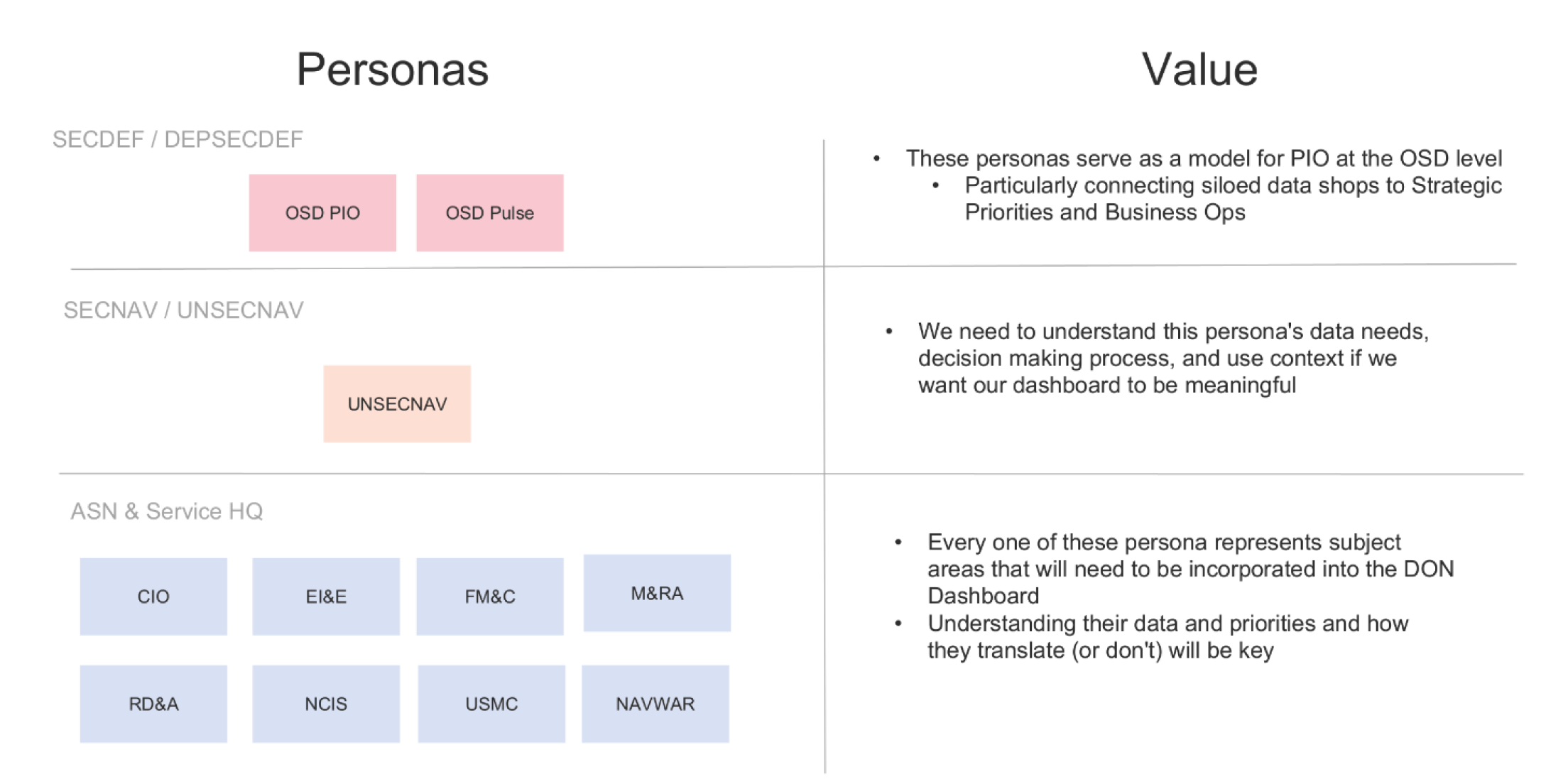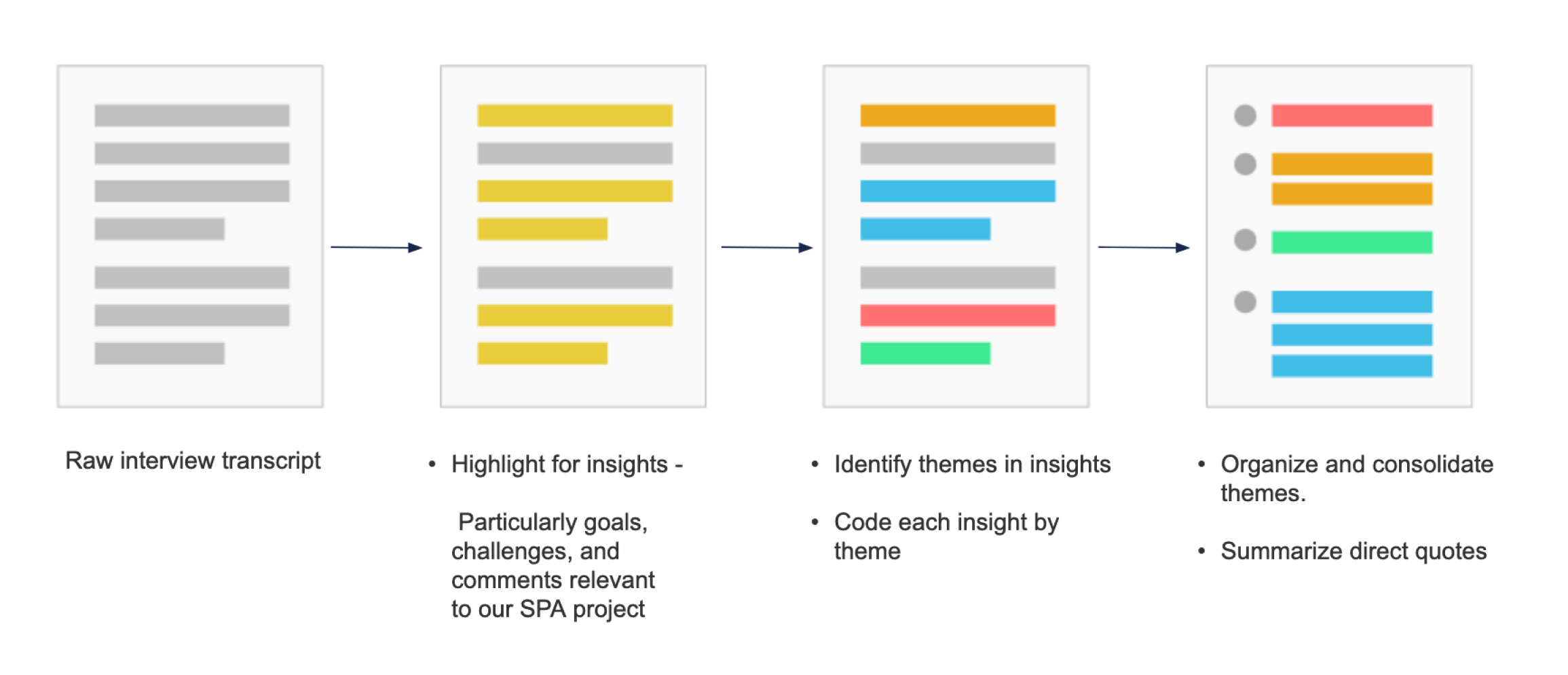Dept. of the Navy
Department of the Navy Stakeholder Analysis
Brand/Project:
Role:
Date:
Context:
The Problem
All the Navy sub-organizations were siloed in terms of their analytics data. We needed to perform outreach to understand how each sub-org was leveraging data, their key measures of performance, and analytics pain points.
* Additional Considerations:
- Many of the stakeholders we needed to engage with were important players in their organization with booked schedules
- The culture within the DoD is relatively hierarchal and politically charged. We needed to be especially sensitive in our outreach and recruiting efforts
The Solution
Two prong stakeholder analysis consisting of outreach and data analysis efforts.
*Note
Because of the nature of the client, the amount of specific information from the interviews and analysis is limited.
Identifying Stakeholders

Like a private company, the Dept. of the Navy has its own organizational structure with top level executives, directors, and it’s own HR, finance, IT, and energy sub-organizations.
We needed to reach out to stakeholders from all these different levels and sub-organizations to understand how they utilize data so that we could work to centralize data collection and processes.
Outreach
- Persona Templates
- Interview Questions
- Email Outreach Template
- Interview Primer
Persona Template
We built out persona templates to get a sense of what data we wanted to collect during our interviews. These were largely role and decision making focused.
- Persona Name
- Rank / Job Title / Role
- Responsibilities
- Goals
- Primary Goals
- Secondary Goals
- Top pain points or challenges the user faces
- Decision-Making Needs
- What drives the user to accomplish their goals
- Data points required for high-level decision-making
- Current information sources
- Metrics that the user monitors
- Other misc. Data Info
- Tasks:
- Daily tasks
- Periodic tasks
- Motivations
- Technology Proficiency
- Preferred Communication Style
- Other software/websites used
- Visual, auditory, or textual
Sample Stakeholder Interview Questions
Below are some of the base interview questions. We wrote wrote additional custom questions tailored to each interviewee as a sign of respect and engagement.
- What are your primary responsibilities within the organization?
- What are the biggest goals you hope to achieve in your role?
- What are the challenges you face in achieving those goals?
- What kinds of decisions do you often make in your role?
- What information do you often use for making decisions in your role?
- How do you usually access that information?
- Are there any specific measures or KPIs you keep track of?
- What information do you often use for making decisions in your role?
- What tools do you currently use to keep track of information or progress?
Sample Outreach Email
[Insert Formal Greeting],
I am reaching out from DON PIO to request 30 minutes of your time for a user interview in support of our office’s development of an Advana-based performance management and improvement tool, the “DON Dashboard.”
The goal of the DON Dashboard is to display and monitor performance across the DON's strategic goals and initiatives. It aims to serve as an enterprise-wide source of performance data, in line with DON PIO’s vision to "be the DON's trusted source of integrated analytics to navigate strategic decisions and achieve improved outcomes."
We are reaching out to our key stakeholders to better understand the current utilization of analytics within your office and learn how we can further support your goals and initiatives with the dashboard. Your input is very important as it will help us create a dashboard that is relevant to users and fully representative of DON performance.
This interview will be an informal question and answer. To better understand what to expect, we have included some of the interview questions below.
Conducting the Interviews
- 16 individual interviews
- Approximately 30 to 45 minutes each
- Conducted over an 8 week period
- Facilitated virtually over Teams
- Audio was recorded and transcribed fro analysis
- Because of the hierarchal nature of the clientele, interviews were conducted by a government lead, with myself taking notes and recording
Transcript Analysis
Audio of the interviews were transcribed and analyzed from reoccurring themes

- Raw interview transcript
- Highlight for insights
- Identify themes and code insight by theme
- Diagnosis Data Trust
The Results
High level document of each sub-org was leveraging data, their key measures of performance, and analytics pain points.
Because of the nature of the project, the final deliverables cannot be shared but here is an outline of some of the key themes that arose.
- Culture Change
- Leveraging data for decision making instead of compliance is relatively new for the DON.
- Strategic Frameworks
- Measuring Performance
- Performance measurement practices were often unique to individual functional areas and departments.
- Functional and Departmental Silos
- Functional area silos create issues for the resourcing of dashboards and data systems.
- Functional area silos create inefficiencies for the management of dashboards and data systems.
- Data Authority
- There is a definite need for transparency regarding source and lineage of data used for decision making.